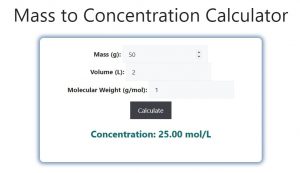About Mass to Concentration Calculator (Formula)
The Mass to Concentration Calculator is a useful tool designed for scientists, researchers, and students working in chemistry and biology. Understanding the concentration of a solution is crucial in various fields, including pharmaceuticals, environmental science, and food technology. This calculator enables users to convert the mass of a solute into concentration, allowing for accurate measurements and formulations in experiments and industrial processes.
Formula
To calculate concentration, the formula is:
Concentration (C) = Mass of Solute (m) / Volume of Solution (V)
Where:
- C is the concentration (typically in grams per liter, g/L).
- m is the mass of the solute in grams (g).
- V is the volume of the solution in liters (L).
How to Use
- Gather Required Data: Obtain the mass of the solute and the volume of the solution. Ensure both measurements are in the correct units (grams for mass and liters for volume).
- Input Values: Enter the mass of the solute and the volume of the solution into the Mass to Concentration Calculator.
- Calculate Concentration: The calculator will apply the formula to compute the concentration.
- Analyze Results: Use the calculated concentration for your scientific applications or experiments.
Example
For example, if you have a solute mass of 50 grams dissolved in a solution volume of 2 liters, here’s how to use the Mass to Concentration Calculator:
- Mass of Solute (m): 50 g
- Volume of Solution (V): 2 L
- Calculate Concentration:
- C = 50 g / 2 L
- C = 25 g/L
In this case, the concentration of the solution is 25 grams per liter.

FAQs
- What is the purpose of the Mass to Concentration Calculator?
It converts the mass of a solute into concentration values for use in various scientific applications. - What units are used for mass and volume in this calculation?
Mass is typically measured in grams (g), and volume is measured in liters (L). - How is concentration usually expressed?
Concentration can be expressed in grams per liter (g/L), moles per liter (mol/L), or percentage (%). - Can this calculator be used for different types of solutions?
Yes, it is applicable to any type of solution as long as the mass and volume are known. - What if my mass is in kilograms instead of grams?
You should convert the mass to grams by multiplying by 1000 before using the calculator. - Is the Mass to Concentration Calculator suitable for beginners?
Yes, it is user-friendly and designed for anyone interested in calculating concentration. - How does the volume of the solution affect concentration?
A larger volume will decrease concentration, while a smaller volume will increase concentration, assuming mass remains constant. - What is the difference between mass and concentration?
Mass refers to the amount of solute, while concentration measures how much solute is present in a given volume of solution. - Can this calculator help in preparing solutions?
Yes, it is useful for determining how much solute to add to achieve a desired concentration. - What happens if I input zero mass?
The calculated concentration will be zero, indicating no solute in the solution. - Are there limitations to using this calculator?
It assumes ideal conditions; real-world factors may influence actual concentrations. - Can I use this calculator for biological applications?
Yes, it is commonly used in biology for preparing media and solutions. - What is a common mistake when using this calculator?
A frequent error is not converting units properly, especially mass. - How can I convert concentration from g/L to mol/L?
You need to know the molecular weight of the solute and divide the concentration in g/L by the molecular weight. - Is there a specific temperature at which concentrations should be measured?
Concentrations can change with temperature, so it’s ideal to measure them at a standard temperature. - Can I use this calculator for non-aqueous solutions?
Yes, as long as you have the correct mass and volume for the solute and solvent. - What resources are available for learning more about concentrations?
Chemistry textbooks, online courses, and educational websites provide valuable information. - Does this calculator apply to environmental science?
Yes, it can be used to calculate pollutant concentrations in environmental samples. - Can this calculator be used for food and beverage applications?
Absolutely, it’s useful for formulating concentrations of flavors, preservatives, and nutrients. - How accurate is the Mass to Concentration Calculator?
The calculator is accurate as long as the input values are correct and in the appropriate units.
Conclusion
The Mass to Concentration Calculator is an essential tool for anyone involved in scientific research and experimentation. By understanding how to convert mass into concentration, users can ensure the accuracy of their measurements and formulations. This calculator not only simplifies calculations but also enhances the effectiveness of various applications across different fields, from pharmaceuticals to environmental science.